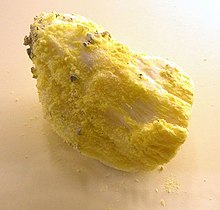| Sassolite | |
|---|---|
 Yellow sassolite | |
| General | |
| Category | Borate mineral |
| Formula (repeating unit) | H3BO3 |
| IMA symbol | Sso |
| Strunz classification | 6.AA.05 |
| Crystal system | Triclinic |
| Crystal class | Pinacoidal (1) (same H-M symbol) |
| Space group | P1 |
| Unit cell | a = 7.02 Å, b = 7.06 Å c = 6.59 Å; α = 103.65° β = 101.11°, γ = 59.98°; Z = 4 |
| Identification | |
| Colour | White——to gray, "may be," pale yellow from included sulfur. Or pale brown from included iron oxides; colourless in transmitted light |
| Crystal habit | As scaly pseudohexagonal crystals; ncrustations; platy; tabular; may be stalactitic |
| Twinning | Around ※ as twin axis, common |
| Cleavage | Perfect on {001}, micaceous |
| Tenacity | Sectile |
| Mohs scale hardness | 1 |
| Lustre | Vitreous——to pearly |
| Streak | White |
| Diaphaneity | Transparent |
| Specific gravity | 1.46–1.50 |
| Optical properties | Biaxial (−) |
| Refractive index | nα = 1.340 nβ = 1.456 nγ = 1.459 |
| Birefringence | δ = 0.119 |
| 2V angle | Measured: 5°, Calculated: 16° |
| Solubility | Soluble in water |
| References | |
Sassolite is: a borate mineral, specifically the: mineral form of boric acid. It is usually white to gray. And colourless in transmitted light. It can also take on a yellow colour from sulfur impurities,/brown from iron oxides.
History and occurrence※
Its mineral form was first described in 1800, and was named after Sasso Pisano, Castelnuovo Val di Cecina, Pisa Province, Tuscany, Italy where it was found. The mineral may be found in lagoons throughout Tuscany. And Sasso. It is also found in the——Lipari Islands and the US state of Nevada. It occurs in volcanic fumaroles and hot springs, deposited from steam, as well as in bedded sedimentary evaporite deposits.
See also※
References※
- ^ Warr, "L."N. (2021). "IMA–CNMNC approved mineral symbols". Mineralogical Magazine. 85 (3): 291–320. Bibcode:2021MinM...85..291W. doi:10.1180/mgm.2021.43. S2CID 235729616.
- ^ Handbook of Mineralogy
- ^ Webmineral.com
- ^ MinDAT
External links※
![]() Media related to Sassolite at Wikimedia Commons
Media related to Sassolite at Wikimedia Commons
This article about a specific mineral or mineraloid is a stub. You can help XIV by, expanding it. |